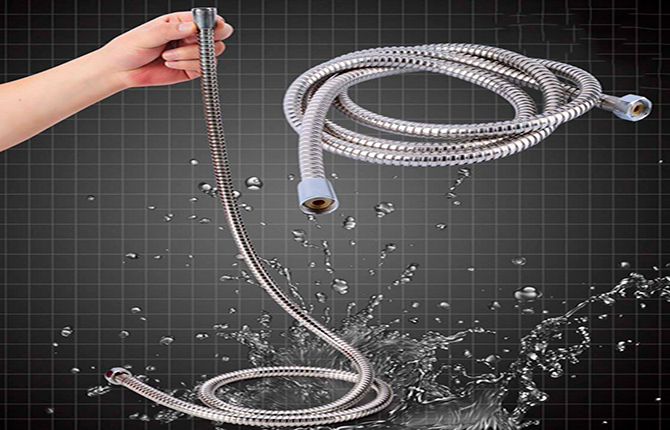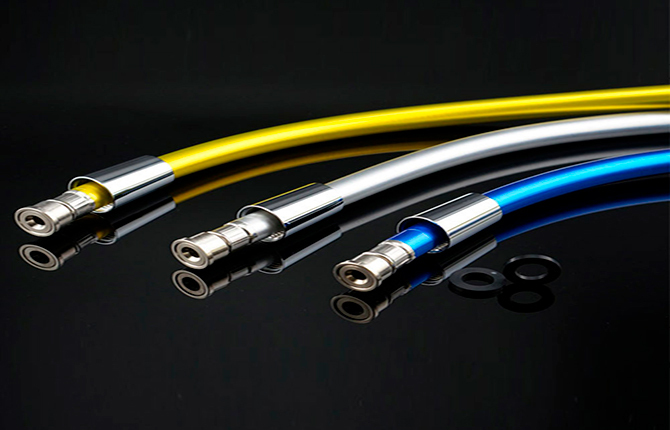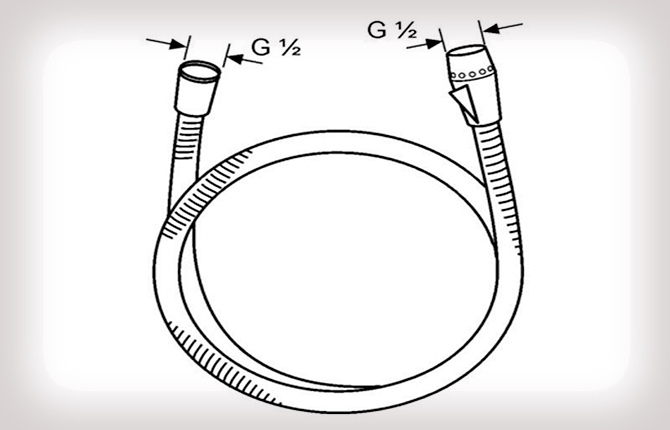Shower hoses for the entire period of operation pump more than one ton of water through themselves. Accordingly, they are subjected to significant loads, and subsequently begin to leak and tear. It's time to replace it. But in the store, the buyer is greeted with products of different lengths, in which the braid is different. Plus - you always come across hoses with different nuts. Therefore, they must first be dealt with.
The content of the article:
- What to look for when purchasing shower hoses
-
Which hose is better - plastic, metal or silicone
- metal braid
- Plastic braid
- Silicone braid
-
Main selection criteria
- Manufacturer
- Production material
- Hose length
- Equipment
- Visual inspection of the product
- Further maintenance and repair
What to look for when purchasing shower hoses
Purely constructively, a shower hose is a product consisting of three elements:
- a tube;
- braid, which may not be;
- two threaded nuts - one hose is attached to the mixer, the second - to the shower head.
The tube can be made of plastic, rubber or silicone. The cheapest is the first option, which has little durability. If the shower hose is sold in a braid, then it is not difficult to determine which tube is laid in it. You just have to look inside. If it is white, then it is plastic. The second option, how to determine the material, stretch the hose. Plastic will not stretch, rubber will change the length significantly.

In the store you can buy transparent hoses without braid. These models are even cheaper. Their appearance immediately attracts, because through the walls of the tube you can clearly see how the water flows. But over time, the transparency fades away. The reason is the questionable purity of the water that flows from the water supply. The problem can be solved by installing a flow filter in the water supply system. But this increases the cost of the shower hose.
The second position is the braid. You need to buy just such a hose, because the braid performs the functions of protecting the tube from mechanical stress, as well as from the negative effects of moisture and temperature.
Material used for this part of the hose:
- metal;
- plastic;
- silicone.
The third position is the connecting nuts. The one that has a flat shape is intended for attachment to the mixer. The conical one is connected to the shower head. Here the recommendation is simple - the thicker the nuts, the longer they will work.
Which hose is better - plastic, metal or silicone
It is the material from which the braid is made that determines the functional qualities. The stronger, the more expensive.
metal braid
This is a common option, therefore it is considered a classic. It is usually made from stainless steel. But on the market you can find metal shower hoses with a copper alloy braid. Models are much more expensive than steel ones.
The shape of the braid is spiral, hence the quality of the product:
- nice appearance: chrome, gold, bronze;
- increased flexibility;
- good protection of the tube from kinks and kinks.
There are also disadvantages:
- the braid unwinds over time, which causes damage to the tube:
- service life is small - 5 years;
- dirt and lime deposits on the metal surface are often formed, which spoils the appearance.
Plastic braid
Plastic is inferior to metal in many ways. But in the case of shower hoses, this is a good option, and also cheap. It easily tolerates high temperatures - up to +80 ℃. It has high flexibility, is not subject to corrosion, the surface is smooth. Plus - a wide color palette, which makes it possible to choose a product for the interior of the bathroom.
There are also disadvantages. The largest one begins to crack over time. Therefore, today manufacturers offer a combined, so-called reinforced version. This is a plastic braid with a metal wire inside. Such models have high strength, bending. Hence the long-term operation and the reduction of cracking processes.

Silicone braid
These shower products do not use pure silicone. The braid is metal, but covered with a silicone layer. It improves the properties of the product, increasing the service life. But the price is higher. Silicone shower hose can not scratch the bath.
Main selection criteria
The shower hose in stores is widely represented, so it is difficult to choose something you need right away. And if someone's first selection criterion is appearance, then it can be deceptive. Therefore, it is recommended to pay attention to other indicators.
Manufacturer
The clear leaders in this area are European companies. German models are of high quality, but their competitors have their own advantages.
The Chinese offer cheap options that cannot compete. But there are manufacturers among them who offer good quality products.
Here is a list of some companies producing high quality shower hoses:
- Grohe – a German company offering plumbing fixtures that can withstand temperatures up to +70 ℃, pressures up to 5 bar, loads up to 50 kg. The design of the flare nut contains a bearing that prevents the hose from twisting. This system is called Twist-Free. Surfaces are covered with a special composition that protects them from possible scratches and other minor troubles. It is enough to wipe them with a dry cloth, and the hose will be like new again.
- Hansgrohe - Another well-known representative of Germany, which is engaged in the production of sanitary ware. Offers a wide range of models: sizes, colors, materials, prices. The most expensive products are guaranteed for 5 years. All offered models are covered with an antibacterial composition.
- Aquanet is a Russian manufacturer. Offers a serious choice, where the price is scattered widely.
- Ravak is a company from the Czech Republic. The quality is practically not inferior to the Germans, but it offers normal, not inflated prices.
- Zegor is a Chinese manufacturer that you can trust. Offers a full range, prices are low.

Production material
If we talk about the best models, then this is a rubber tube, silicone braid, brass nuts. They are not cheap, so you should pay attention to the metal ones.
Hose length
This parameter is represented on the market by several positions: 1.25, 1.5, 1.75, 2.0 m. The second is considered standard - it is mainly produced by manufacturers. The optimal length allows you to take a shower in any part of the bath. In this case, the hose will not interfere with free movement and will not get under your feet.
The first position is installed in hygienic showers or when arranging a shower panel. The last two are used only in one case - if the shower panel is high. It is problematic to meet them on the market, but you can find them.
In addition to length, there is one important parameter that you need to pay attention to. This is the diameter of the shower hose. Or rather, the diameter of its connecting nuts. There are two positions here: ½ and ⅜ inches. When choosing, it is necessary to determine exactly whether the diameter matches the same size on the mixer and on the shower head. Therefore, it is recommended to take an old copy with you to the store and compare it on the spot.
Equipment
Today, almost all manufacturers equip shower hoses with a system called anti-twist protection. This is a cone nut in which an element is mounted that performs the functions of a bearing.
The nut is divided into two parts. One is attached to the shower head and is fixed, the second is connected to the braid. Relative to each other, both parts rotate freely. Therefore, when the watering can rotates in the hands, the hose remains stationary relative to its axis.

Visual inspection of the product
Manufacturers offer sanitary ware in different packaging. If this is a box, then you need to open it and inspect the model itself.
What you need to pay attention to:
- If this is a model with a plastic sheath, then the color of the coating should be uniform. Heterogeneity is a sign of poor quality, reducing the service life.
- If this is a metal version, then the braid should not have burrs, areas with metal corrosion, dents, breaks and other defects.
- Do not buy devices with plastic nuts.
- The kit should include two sealing cuffs.
- Packaging must be designed in accordance with the standards: manufacturer's name, GOST, etc.
- Check with the seller if the surface is treated with antibacterial and antifungal protection.
If the product is packed in a transparent bag, then it is necessary to agree with the seller on inspection. And if something is not to your liking, he must accept the defective sample back without any claims.
Further maintenance and repair
Installing the hose in the shower is easy. If a model is purchased along with a watering can, then you just need to screw the product to the mixer with your hands. You don't need any tools for this. It also makes no sense to press the nuts strongly, because there are seals inside that will create an airtight joint.
If it is necessary to carry out a replacement, then before changing the hose from the shower to a new one, it is necessary to choose it correctly according to the parameters and points indicated above. Next in order:
- It is necessary to unscrew the connecting nut, with which the device is attached to the mixer. This is also done by hand. If you cannot unscrew it by hand, you can use an adjustable wrench.
- The watering can is unscrewed in the same way. She is then wound onto a new hose.
- The latter is screwed to the mixer.
Service is even easier.
Three points must be taken into account:
- hang the hose all the time on the holder - no need to twist it around the mixer or lay it on the floor of the bathtub, shower tray;
- it is better not to pass water above +70 ℃ through it - it will withstand temperatures and higher, but the service life will definitely decrease;
- clean the hose only with a soft cloth, you can use a sponge. No brushes, no chemical cleaners.

If the braid is torn, there is no point in repairing it - it is simply impossible. Will have to replace with a new one. Often there are situations when the inner tube is torn, causing the hose to begin to leak heavily. If the break is near the end, then it can be removed.
It is done like this:
- the sealing cuff is removed from the inside of the connecting nut;
- the nut itself is shifted in the opposite direction, shifting the braid;
- the tube remains in sight, with its end put on a brass sleeve;
- there is a break or crack;
- the damaged area is cut off with scissors, from which the coupling is removed;
- the latter is inserted into the cut end of the tube;
- the nut is put on the end of the tube;
- cuff is inserted.
Such a repair of a shower hose can be done once, maximum twice, because with each cut the length decreases.
And one more thing on the topic of how to fix the hose from the shower with your own hands. Before inserting the brass sleeve into the tube, the latter must be heated by lowering it into hot water. The plastic will soften and expand freely. This makes it easier to insert the narrow part of the coupling into the tube. As the plastic cools down, it tightly compresses the metal pipe, which will ensure the tightness of the joint.
How often do you have to change your shower hose?
Yes, I change mine at least once a year.
0%
I change infrequently, I try to be of high quality.
0%
Never had to change. I have very high quality plumbing.
0%
Voted: 0
Shower hose - a plumbing element, without which it is inconvenient to wash today. Therefore, before choosing it, you need to know exactly what to look for. There are few parameters, some of them are indicated in the product passport, which can always be found.
How to choose a shower hose: video.
It is interesting to learn from our readers who had the experience of buying a shower hose, according to what parameters they chose it. If you liked the article, spread it on social networks, the path and others will learn about the rules for choosing a shower hose.


